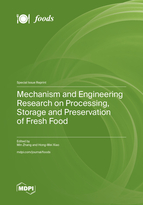Mechanism and Engineering Research on Processing, Storage and Preservation of Fresh Food
A special issue of Foods (ISSN 2304-8158). This special issue belongs to the section "Food Packaging and Preservation".
Deadline for manuscript submissions: closed (31 May 2023) | Viewed by 26736
Special Issue Editors
Interests: fresh food; processing, storage; preservation; fresh food supply chain, packaging; transportation; functionality; safety; freshness
Interests: fruits & vegetables; processing; preservation
Special Issues, Collections and Topics in MDPI journals
Special Issue Information
Dear Colleagues,
The COVID-19 pandemic has highlighted the fragility and importance of the fresh food supply chain system. The pandemic has affected the production and transportation of high-value, labor-intensive, perishable, and nutritious fresh foods, such as fruits and vegetables, meat, and aquatic products. On the other hand, changes in the characteristics of microorganisms, production methods, environment and ecology, and the increasing amount of fresh food in world markets have created new risks. Over the years, food preservation processes have satisfied consumers’ increased demand for high-quality fresh foods. Consequently, exploring the novel technologies of processing, storage, and preservation is becoming essential for fresh food. Innovative and promising technologies have been adopted to ensure safe productions with changing consumer needs and fresh food-health issues. The aim of this Special Issue is to collate a range of original research and review articles on the latest progress, challenges, and prospects of new processing, storage, and fresh-keeping technologies for fresh food.
Prof. Dr. Min Zhang
Dr. Hong-Wei Xiao
Guest Editors
Manuscript Submission Information
Manuscripts should be submitted online at www.mdpi.com by registering and logging in to this website. Once you are registered, click here to go to the submission form. Manuscripts can be submitted until the deadline. All submissions that pass pre-check are peer-reviewed. Accepted papers will be published continuously in the journal (as soon as accepted) and will be listed together on the special issue website. Research articles, review articles as well as short communications are invited. For planned papers, a title and short abstract (about 100 words) can be sent to the Editorial Office for announcement on this website.
Submitted manuscripts should not have been published previously, nor be under consideration for publication elsewhere (except conference proceedings papers). All manuscripts are thoroughly refereed through a single-blind peer-review process. A guide for authors and other relevant information for submission of manuscripts is available on the Instructions for Authors page. Foods is an international peer-reviewed open access semimonthly journal published by MDPI.
Please visit the Instructions for Authors page before submitting a manuscript. The Article Processing Charge (APC) for publication in this open access journal is 2900 CHF (Swiss Francs). Submitted papers should be well formatted and use good English. Authors may use MDPI's English editing service prior to publication or during author revisions.
Keywords
- fresh food
- processing, storage
- preservation
- fresh food supply chain, packaging
- transportation
- functionality
- safety
- freshness








